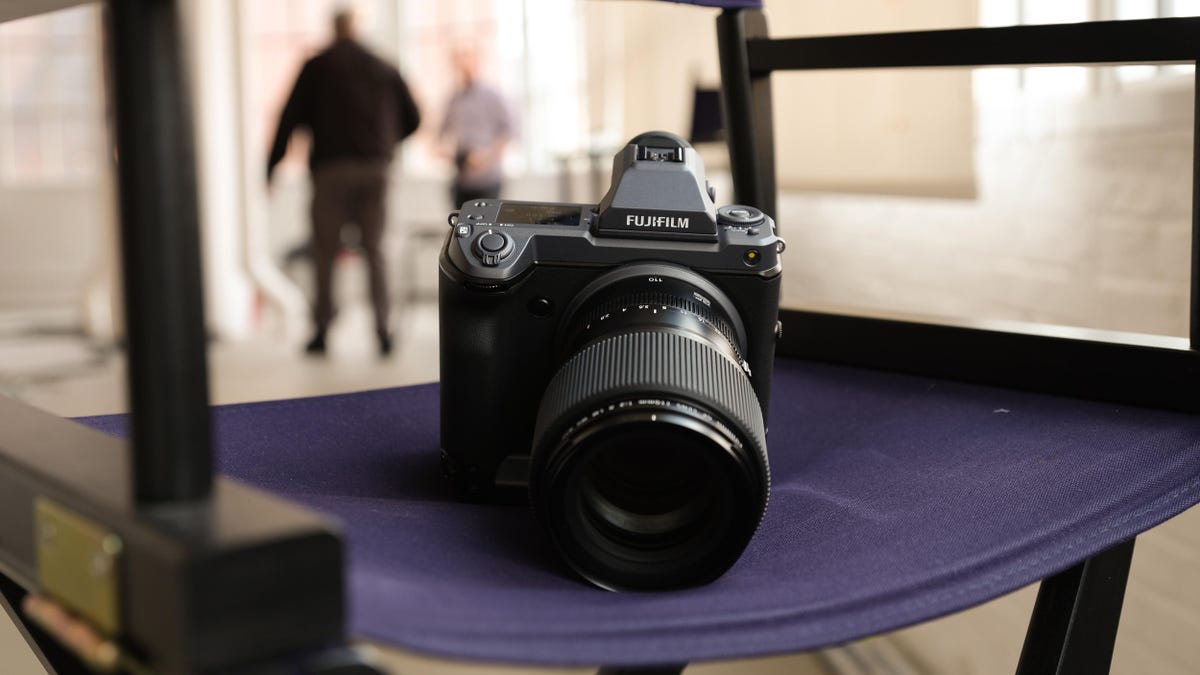Fujifilm's $10K GFX100 is the most versatile medium-format camera ever
A 102MP sensor, 4K video, in-body image stabilization, full-res 5fps shooting with tracking and a hybrid autofocus system makes this seem like a terrifically well-rounded camera.

The GFX100 is substantially larger than the GFX 50S.
Fujifilm follows up its 50-megapixel mirrorless medium-format GFX 50S and 50R models with the 102MP GFX100, both the least- and most-Fujifilm-like camera the company's delivered in quite a while. It's pure Fujifilm in the way that matters: X-T3-like autofocus with fast-for-its-class continuous shooting, 4K video capture, plus the desirable five-axis sensor-shift image stabilization capability that it briefly debuted in last year's X-H1 but didn't appear in subsequent cameras.
The camera incorporates a medium-format BSI (backside illuminated) sensor, the architecture now used by many of the cameras shipping today. It enables better low-light sensitivity and the performance necessary to shoot 4K video or focus tracking while continuous shooting.
Its $10,000 price tag -- equivalent to about £7,896 and AU$14,550 -- seems roughly what you'd expect given Fujifilm's other models. Whether or not it's worth it depends on a lot of unknowns, including the sensor's dynamic range, image quality and general performance. The camera is slated to ship by the end of June.
Just like stepping up from a mainstream camera with an APS-C-size sensor to a larger full-frame model, upping from full-frame to medium format provides benefits like shallower depth-of-field for a given lens aperture and (usually) broader dynamic range because of the larger sensor, even though they cram more pixels into the sensor.
Shot with a preproduction version of the GFX100 (and scaled down a lot). Because the raw software was not yet ready, we only had access to JPEGs, so can't really make any determinations about the sensor or image quality.
In the short time I got to use it, the autofocus seemed quite snappy. But it's impossible to draw any conclusions from the handful of JPEG images I shot except that they're big and sharp with pretty colors -- all completely unsurpising.
Highlights include:
- Up to DCI 4K/30p video (it uses the full width of the sensor), with 4:2:0 8-bit internal or 4:2:2 10-bit external with most video capabilities same as the X-T3.
- 5fps continuous shooting with focus tracking at full resolution and 14-bit color (standard is 16 bits) using Fujifilm's X-Processor 4, the same quad-core processor that's in the X-T3. While 5fps may not sound like much, it's practically zippy compared to other medium-format models.
- On-sensor phase-detection autofocus (about 3.8 million PD sensors) covering almost 100% of the frame plus the 425-point contrast autofocus as the GFX 50S. Focus sensitivity as low as -2 EV.
- Native sensitivity of ISO 100 - ISO 12800, with expansion down to ISO 50 and up to ISO 102400, similar to the GFX 50S.
- The same 3.7MP OLED viewfinder as the GFX 50S.
- Dust and weather resistance.
- Dual UHS-II SD card slots, mic and headphone jacks and a USB-C connection.
The GFX100 veers from Fujifilm tradition with its design -- in a good way. It sports no retro camera dials and has built-in vertical grip that holds two batteries.
Physical dials are more a curse than a blessing for shooting video, at the least because you want different presets or defaults for stills and video and the physical dials override those. And mirrorless cameras' battery life is bad enough in general, with the sensor stabilizer draining them even more, that you want to carry multiples. The GFX100's rated life is 800 shots for a pair.
In fact, the body design bears little resemblance to the earlier GFX models. All told, the GFX100 is roughly the size and weight of the full-frame Nikon D5, though you can remove the viewfinder if you choose. Not only is the sensor large compared to a full-frame -- it's 43.8x32.8 mm compared to 36x24mm -- but it's floating in the stabilization mechanism, so the whole unit takes up quite a bit of space.
But Fujifilm couldn't let go of its shutter speed and ISO dials entirely. The top display cycles through several readouts, one of which presents you with virtual versions of the two dials. I found them a little glitchy to use -- when rotating I'd end up on the wrong settings because of the way the display updated, though they were preproduction units so that may change. But they also seemed unnecessary.
A drive mode button and mode switch sits on the left shoulder, while the back controls are pretty typical Fujifilm. It incorporates the multiangle tilting touch display as the X-T3. While it's nice to have the capability, I've always found the implementation a little cumbersome to use quickly and precisely.
It also has the duplicate setting display you'd find on a pro model like the D5 or the Canon EOS-1D X Mark II, and both the horizontal and vertical grips are comfortable enough to handle the weight of the body and the lens, much like the GFX 50 series. The off-center viewfinder means it feels different shooting horizontally than it does vertically, which may bother some people.
The GFX models have always felt like the most mainstream of the medium-format cameras -- even the "casual" Hasselblad X1D felt like it belonged in the studio more than the street -- and the capabilities added in the GFX100 make it seem like a perfect step up from a full-frame model -- DSLR or mirrorless -- for event photography. I hope Fujifilm decides to bring the speed and versatility down to a lower resolution like 50MP, and therefore a lower price.
Updated May 28, 2019: Corrected the misstatement about this being the first to use a 100-megapixel BSI sensor.

